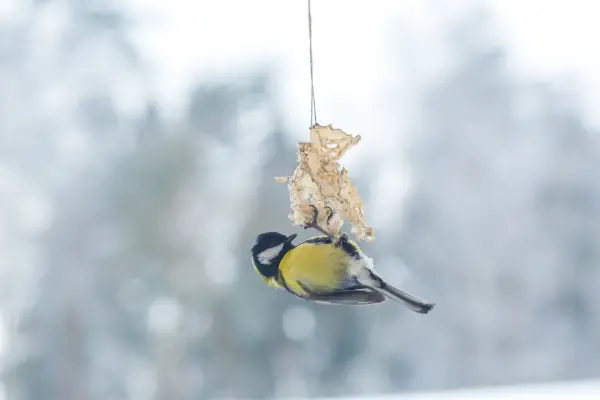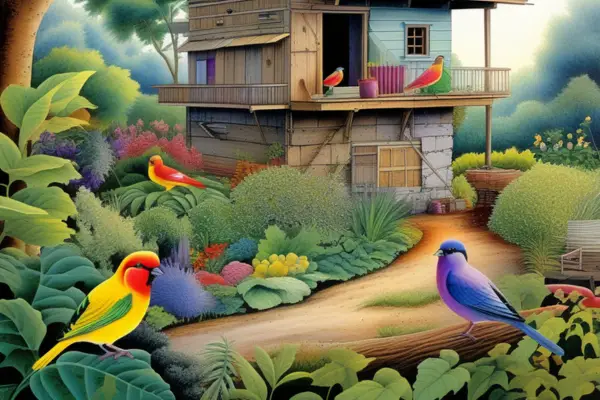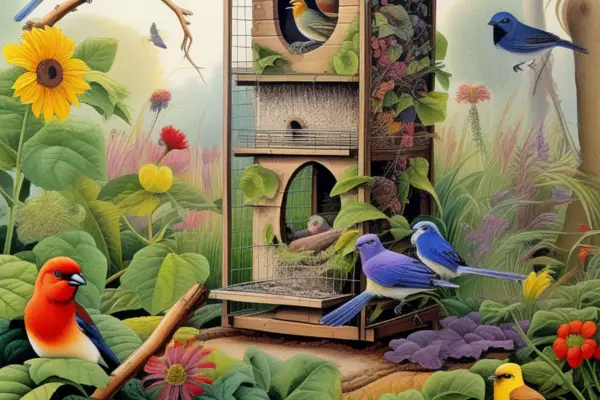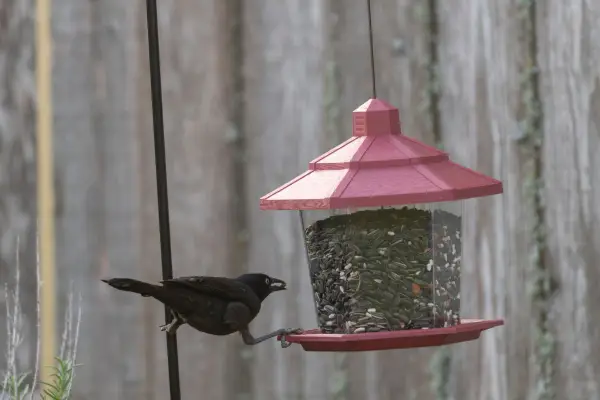How Long Do Backyard Birds Live?
As I sit by my window watching a pair of cardinals flit around my backyard bird feeder, I wonder – how long will these colorful songbirds live? After years of hosting countless backyard birds, I’ve noticed their lifespans can vary greatly. A chickadee at my feeder survives year after year, while some robins only visit for a season or two at most.
But what factors determine backyard bird longevity? Does creating bird-friendly backyard habitats really impact their health and survival? My curiosity drove me to research common backyard birds and discover what we can do to support their lifespans.
I learned fascinating insights on how long birds live, from tiny hummingbirds to large crows, and practical ways we can make a difference.
Size Matters: Lifespan and Bird Size
A general rule of thumb is that smaller bird species have shorter lives while larger birds survive several years. The smallest backyard birds, hummingbirds, live an average of 3-5 years. Larger crow-sized birds may live up to 14 years.
Why does size influence lifespan so much? It likely relates to metabolism and risk. Smaller birds have very fast metabolisms; all that energy needed for hovering and flitting drains their system. They are also vulnerable to predators and harsh weather due to their diminutive size. Larger birds face fewer threats and need less energy, enabling their longevity.
Backyard birders are familiar with these petite powerhouses – hummingbirds are the smallest birds commonly seen. Their breakneck speed and agility come at a cost, wearing out their tiny bodies after just a few brief years of life. In contrast, American crows are substantially larger backyard visitors. Their formidable size, cunning nature, and adaptable diet allow some to survive over a decade.

Threats Lurking: Predation Risk and Backyard Birds
Predation is a constant threat for our feathered friends, impacting mortality rates and cutting some backyard birds’ lives short. Birds must balance finding food while vigilantly watching for cats, hawks, snakes, and other predators.
Nestlings and fledglings are particularly vulnerable, with as many as 70% dying in their first year. Surviving that initial year is crucial for backyard birds’ longevity.
As habitats shrink, birds increasingly nest and feed near human homes where predators abound. Outdoor cats are likely the top backyard bird predator. Studies show our feline friends kill over 2 billion birds annually in the U.S. alone. Hawks and owls also snatch songbirds from backyard feeders and nests. Snakes raid nests full of eggs and babies. Jays and crows steal eggs and nestlings.
These threats underscore why habitat buffers and native plant sanctuaries are vital around yards. They give birds a fighting chance at survival by providing safe spaces. Thoughtful backyard management can help bird families successfully raise young while avoiding dangers.
Home Sweet Home: Backyard Habitats and Bird Lifespans
In addition to contending with predators, backyard birds need suitable places to nest plus abundant food to fuel their high metabolisms. Access to high-quality habitat directly influences songbird longevity. Yards landscaped with native plants and diverse food sources go a long way toward supporting bird health and welfare.
Offering clean water for drinking and bathing is another way yards can positively impact bird lifespan. Consider installing a backyard pond, bird bath, or drippers to provide water sources.
Protect birds by changing water frequently to prevent mosquitoes. Strategically placed brush piles, rock walls, and bird houses also encourage safe nesting sites.
By understanding backyard birds’ habitat needs and properly managing yards, we enable thriving bird communities. Our gardening choices directly influence the quantity and quality of food sources available.
Diverse native plants foster abundant insect populations birds relies on to feed their young. Backyard sanctuaries become lifelines for birds to rest and refuel during migration. Intentional stewardship leads to healthier, longer-lived birds brightening our days.

Human Influences: Dangers Backyard Birds Face
As human development expands dramatically, it introduces new perils for birds sharing our backyards. Birds face risks from window collisions, pesticides, invasive species encroachment, and climate change contributing to habitat loss. Each of these issues may negatively impact backyard bird health and longevity.
Window collisions are a severe problem facing many backyard songbirds. Windows reflect inviting landscapes that birds don’t realize are fake. Over 600 million birds die flying into U.S. windows annually according to the Fish and Wildlife Service. Using decals and screens helps prevent crashes that can debilitate or kill backyard visitors.
Pesticides pose insidious backyard threats for birds ingesting tainted insects or exposed seeds. Studies show commonly used lawn insecticides and herbicides accumulate in bird organs and bones. These chemicals can weaken birds and potentially reduce their lifespans. Eliminating pesticides creates healthier backyard habitats.
Invasive plants are another challenge as they disrupt native ecosystems and displace specialized regional plants. Encroaching exotic species significantly impact bird food availability and nesting options. Managing yards to minimize invasive plants assists bird populations under pressure.
As climate change accelerates altering landscapes, birds lose sync with adapted migration and breeding cycles. Backyards can provide pitstops with suitable food, water and shelter to support birds during seasonal transitions. Creating bird-friendly spaces helps them better withstand extreme weather events and changing habitats.
Sick Birds Don’t Sing: Disease & Bird Longevity
Disease and parasites plague wild birds already facing numerous survival challenges from predators to starvation to storms. Illness combined with these stressors weaken backyard birds’ immunity and may shorten their lives.
Bacterial and viral diseases pose high risks, especially for birds concentrated at backyard bird feeders spreading germs rapidly. Salmonella outbreaks are common. Avian malaria protozoa carried by mosquitoes can also quickly sicken birds. Providing clean water sources and routinely cleaning feeders helps keep yards sanitary.

External bird parasites like fleas, lice and mites uncomfortably irritate our feathered pals. While not typically lethal alone, combating infestations taxes birds already struggling with other threats like extreme weather or dwindling food supplies. Supporting backyard bird health through improving habitats can increase parasite resilience.
A Closer Look at Lifespans of Popular Backyard Birds
| Bird | Average Lifespan | Size | Interesting Longevity Facts |
|---|---|---|---|
| American Robin | 2 years | 10 inches long | – Longest recorded lifespan is 14 years <br> – Only 25% of young survive first year |
| Black-capped Chickadee | 2-3 years | 5-6 inches long | – Oldest banded chickadee recorded was 12 years old <br> – Chickadees can remember thousands of hiding spots for seeds, which aids survival |
| Blue Jay | 7 years | 9-12 inches long | – Some have survived up to 17 years in wild <br> – Noisy flocks help locate food sources |
| Cardinal | 1-3 years | 8-9 inches long | – Oldest wild cardinal was almost 15 years old <br> – Bright red males are vulnerable to predators |
| Chipping Sparrow | 2-3 years | 5-6 inches long | – Prone to crashing into windows while migrating <br> – Nest survival is only 46% due to predators |
| Dark-eyed Junco | 2-3 years | 6 inches long | – Distinguished by dark hood and eyes <br> – Nest in concealed spots like under shrubs and eaves |
| Eastern Phoebe | 3-4 years | 6 inches long | – Named for distinctive “phoebe” call <br> – Often reuse nests or manmade structures |
| Goldfinch | 5-6 years | 5 inches long | – One of the latest nesting songbirds <br> – Bright yellow males stand out against gray females |
| House Finch | 5 years | 6 inches long | – Relative newcomers to Eastern U.S. <br> – Males develop red hue on head and chest |
| Hummingbird | 3-5 years | 3-4 inches long | – Smallest North American bird <br> – High energy needs and metabolism |
| [Tufted Titmouse](https://www.allaboutbirds.org/guide/Tuft |
Boost Backyard Bird Longevity
Supporting backyard bird health and welfare directly translates to more birds delighting us longer through the seasons. A few simple improvements make yards safer sanctuaries and expand bird lifespans.
Landscaping intentionally by adding native plants that provide seeds, nectar and fruits birds seek out is a great first step. Expand vertical space by hanging bird feeders at varying heights catering to birds large and small. Include suet feeders as high-energy nourishment during winter and migration.
Also make yards safer for birds by affixing decals to windows, keeping cats indoors, and eliminating pesticide usage. Installing nest boxes suited to species like bluebirds offers secure housing. Position boxes away from feeders and occupied nests to minimize conflicts.
Monitoring and reporting on bird families through citizen science projects gives helpful insight on bird populations and longevity patterns. Contributing useful data ultimately boosts backyard bird preservation success and improves policies supporting vulnerable species.

The Gift of Birdwatching
Developing bird-friendly backyards rewards us with vibrant avian animation and surrounded songs. But even more profoundly, stewarding backyard habitats gifts wild birds the promise of longevity as best we can foster.
By thoughtfully providing shelter, forage and security tailored to their unique needs, we catalyze thriving bird communities. And thriving birds mean flourishing backyards and enduring wonder gracing our everyday lives.
What You Can Do
- Create native plant sanctuaries with seeds, berries and nesting material
- Eliminate pesticide use
- Install decals on windows to prevent collisions
- Set up bird feeders and change food regularly
- Furnish fresh water for drinking and bathing
- Hang bird houses suited for species in your region
- Join citizen science project tracking bird populations
- Keep pet cats indoors to protect wildlife
The more we understand the factors influencing backyard bird health and survival, the better equipped we become at intentionally manage yards and supporting their welfare through the seasons. Developing habitats with birds’ needs in mind cultivates biodiverse sanctuaries benefitting countless species. And nothing stirs the soul like seeing vibrant birds darting around your backyard for years to come.


